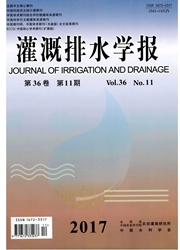

 中文摘要:
中文摘要:
为了进一步明确玛纳斯河流域土壤质地对机采棉水热状况及生长发育的影响,通过测坑试验,对3种不同土壤质地(壤土、砂土、黏土)下的土壤温度、土壤含水率、机采棉、株高、叶面积及产量进行了对比分析。结果表明,不同土壤质地条件下地温日变化及不同时间段温度增量表现为:砂土〉黏土〉壤土;不同土壤质地条件下0~60 cm和0~100 cm土层土壤质量含水率大小顺序为:黏土〉壤土〉砂土;不同土壤质地下机采棉的生长及产量均表现为壤土〉黏土〉砂土。研究认为壤土质地种植机采棉,提高了其生育前期的土壤温度,有效保持了土壤水分,有利于其生长发育。因此,为了提高水分利用效率及产量,建议玛纳斯河流域应增加壤土质地种植机采棉的比例。
 英文摘要:
英文摘要:
This paper presents the results of an experiment in the basin of Manasi River aimed to test the impact of soil texture on change in soil water and temperature, as well as the growth of machine-harvest cotton grown inlysimeters. Three soils:loamy soil, sandy soil and clay, were examined. During the experiment, we measured the soil moisture distribution, plant height, leaf area, and the yield. The results showed that the impact of soil texture- on soil moisture and temperature was in the order of sand〉loam〉clay. The soil moisture contents in 0-60 cm and 0-100 cm of the soilwas in the order of clay〉loam〉sand. The loamy soil gave the highest yield and plant growth due tothe improved soil moisture and temperature. For improving water use efficiency and yield, therefore, the loamy soil should be considered ahead of the sandy and the clay soil in growing cotton in the Manasi River Basin.
 同期刊论文项目
同期刊论文项目
 同项目期刊论文
同项目期刊论文
 期刊信息
期刊信息
